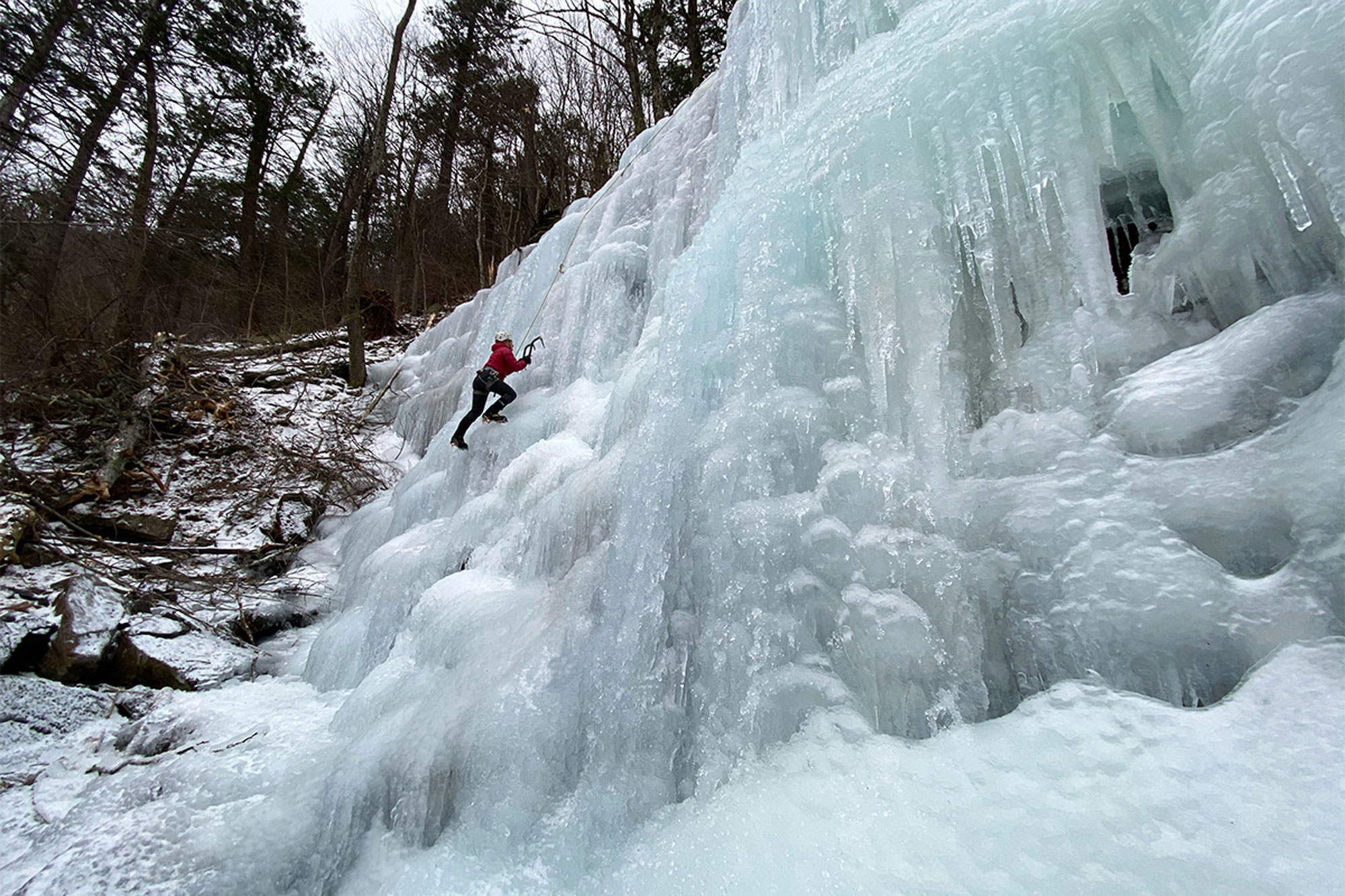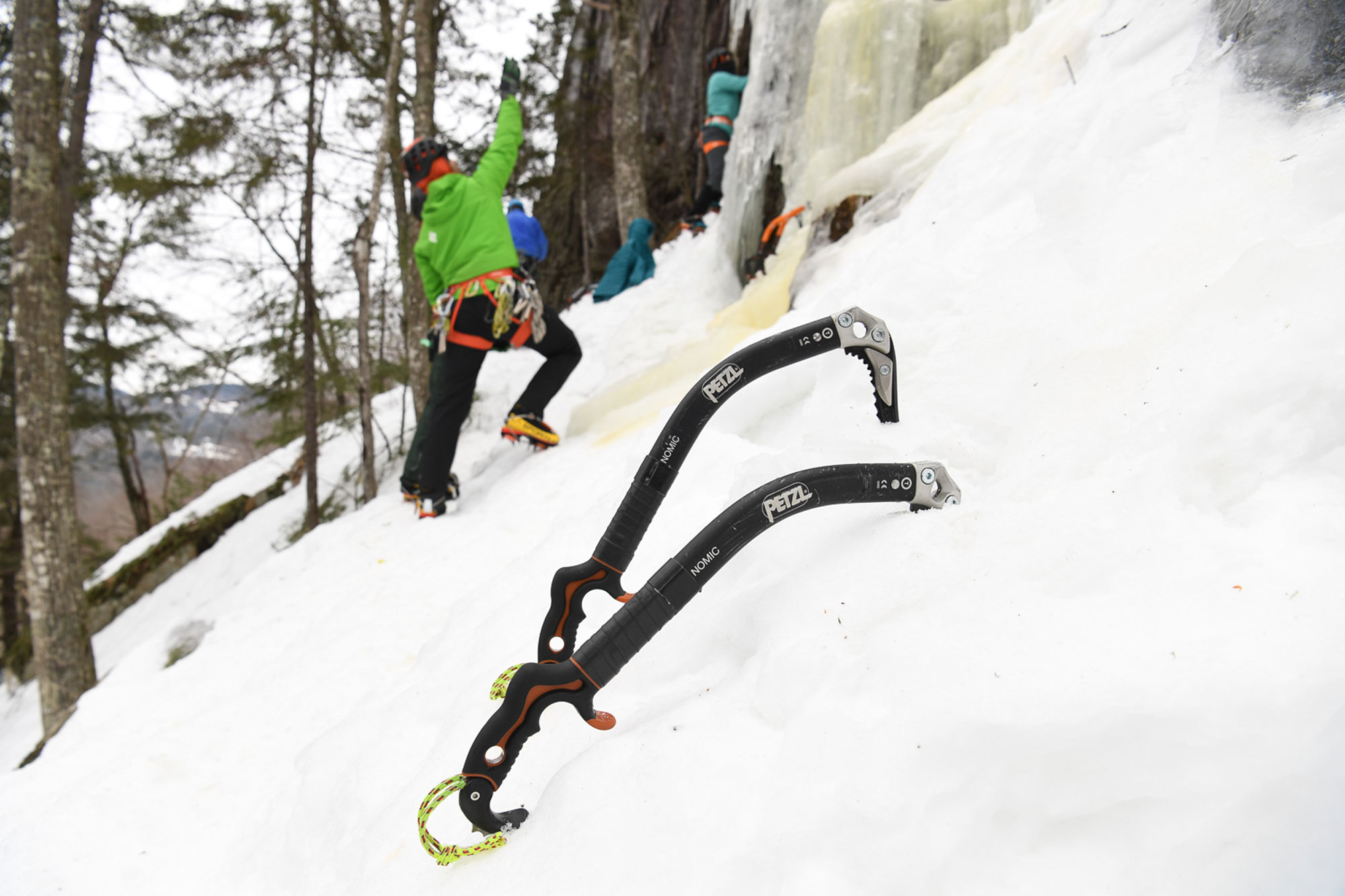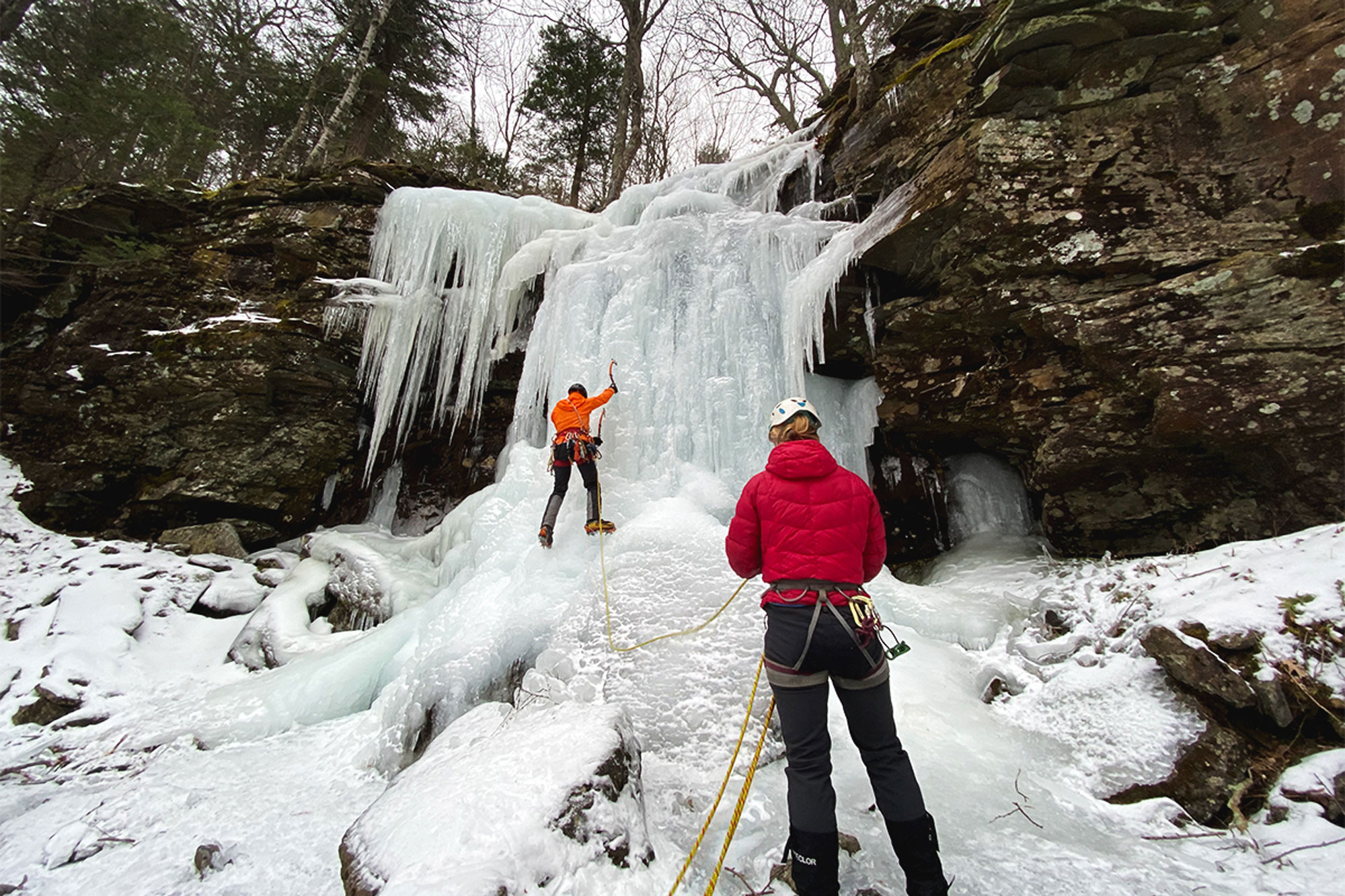The deep, dark recesses of Kaaterskill Clove, in the eastern Catskills, are home to some of the area’s best ice climbing. Noteworthy areas include the popular roadside destination of Moore’s Bridge, the looming pillars of Kaaterskill Falls and the long, tiered waterfalls known collectively as The Ravines. The Ravines—including Hillyer, Viola, Wildcat, and Buttermilk—offer some of the Cats’ best long, moderate routes: All weigh in at between four and six pitches in length with a difficulty in the WI3 to WI4 range. The relatively long, strenuous approaches make for a full day affair and lend a remote, backcountry vibe to each. Moreover, their northerly aspect makes for reliable ice throughout the season.
The most accessible of the bunch is Hillyer. Hillyer Ravine climbs about 200 feet in four moderate pitches with each going at around WI3. Substantial ledges separate one pitch from the next and, though you won’t likely see the same number of people here as you would elsewhere in the Cats—the rigor of the approach and the dearth of parking thin the crowds out a bit—there is plenty of room for multiple parties to set up shop. The wide second and third pitches in particular offer a ton of climbable ice and an entire day could easily be spent doing laps on these two pitches alone.
All in all, a day in Hillyer Ravine is a day well spent. And, like any day out, proper preparation and equipment is key—here’s what you need to bring to climb Hillyer.

Beal Booster 9.7mm Dry Rope
No single tier of Hillyer Ravine stretches higher than 50 feet so a single 60 meter rope will be more than enough—but be sure it’s a dry one. Dry-treated ropes have a coating that prevents water absorption which, on ice, is critical. A frozen climbing rope can ruin your day real quick. The Beal Booster 9.7 mm Dry Rope is a good bet to keep things running smoothly and safely.
Black Diamond Momentum Harness
Whether you’re climbing ice, rock, or indoors, a harness is compulsory. For ice, get one with adjustable leg loops—to account for thick winter layers like the Black Diamond Momentum (men’s/women’s). A couple of Petzl Caritool Evo Holders are a good add for racking screws on the way up and tools on the way down.

Petzl Nomic Ice Tools
There are many types of ice axes, each with their own specific utility. For vertical ice like what you’ll find on Hillyer, a pair of technical ice tools—so defined by their bent shaft, curved pick, and offset grip—are the way to go. The Petzl Nomic is a balanced, workhorse of a tool that’s great for the variety of terrain you’ll find in the Ravines.
Black Diamond Cyborg Pro
Like ice axes, crampons also come in a wide range of shapes and sizes, each designed for a specific function. Crampons with vertical front points like the Black Diamond Cyborg Pro, clipped into a pair of stiff-soled mountaineering boots like the La Sportiva Nepal Evo GTX will get you up Hillyer—and most other routes in the Cats, for that matter—no problem.

Ice Rack
The overwhelming majority of routes in the Catskills are doable with a fistful of ice screws. A couple of Petzl Laserspeed Ice Screws in the 13 to 17cm range will have you covered in Hillyer Ravine. A good bit of cord is definitely handy for building belays between pitches too—20 feet of Sterling 7mm Accessory Cord, two Petzl Attaché Locking Carabiners, and a sturdy tree will make you a nice monopoint anchor.
Tip: The guidebook, An Ice Climber’s Guide to the Catskill Mountains, provides greater detail on what constitutes a typical Catskills ice rack—as well as everything else you need to know about the area.
Outdoor Research Vigor Midweight Sensor Gloves
Keeping your hands warm and dry is a constant challenge on any winter outing and this rings especially true for ice climbing when your arms are elevated and circulation is limited. A pair of gloves that split the difference between warmth and dexterity—like the Outdoor Research Vigor Midweight Sensor Gloves (men’s/women’s)—will help ward off the dreaded screaming barfies while allowing you to still place screws and clip ropes effectively. Bring two pairs so you can easily replace one if they get soaked.

EMS Feather Pack Hooded Jacket
Staying warm and dry is incredibly important in any winter activity, and layering properly is the best way to do it. The layers you’re going to want to use will largely depend on the conditions but, on a backcountry climb like Hillyer Ravine, it’s important to be prepared for everything with lightweight, packable options. In warmer weather, when things get wet, a light hardshell, like the Marmot Precip Eco Jacket (men’s/women’s) makes things a lot more comfortable. In colder weather, an insulated jacket like the EMS Feather Pack Hooded Jacket (men’s/women’s) keeps the heat in while gearing up, belaying, or having lunch.
Trail Spikes
Clocking in at one mile with 1000 feet of elevation gain from the parking area to the base of the climb, Hillyer Ravine’s approach is a stiff one. Conditions on the well-worn climbers’ trail vary but you can bet on the need for traction. Toss a pair of the new EMS Ice Talons in your pack and you’ll be ready for whatever.
Tip: Hillyer Ravine shares most of its approach with neighboring Viola Ravine and it’s not uncommon to tick both in the same trip by climbing one, rappelling the second, then reversing the order.
John Lepak
John Lepak is an art director, graphic designer, and weekend mountaineer. He hasn’t met a rock scramble he didn’t like, and spends his free time either in the mountains or obsessively cooking Mexican food. When John isn’t pushing pixels, crushing miles, or making the best carnitas caseras you’ve ever tasted, you can find him living the dream in the Connecticut woods with his family. Follow him at @jhlepak.




